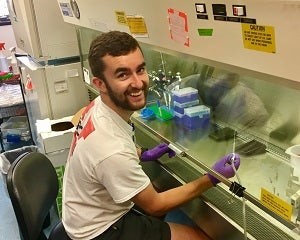Physiological Basis of Human Disease
About
 Research in Physiological Basis of Human Disease at UVA aims to elucidate the cellular and molecular mechanisms of basic biological phenomena and to understand the pathological alterations of these processes that result in disease.
Research in Physiological Basis of Human Disease at UVA aims to elucidate the cellular and molecular mechanisms of basic biological phenomena and to understand the pathological alterations of these processes that result in disease.
Our research seeks to integrate insights gained at the molecular and cellular levels into the broader framework of organ function, with the goal of understanding the function of living systems at all levels. This understanding is based on knowledge of atomic and molecular structure and function. Thus a modern molecular physiologist may investigate the function of the heart by cloning a membrane channel or transport protein, expressing it and studying its kinetics through patch clamping in a model cell system, while exploring the relationship between molecular structure and function through crystallography and spectroscopy.
We emphasize interdisciplinary systems approaches. Consequently, members of our program are associated with many departments in basic sciences, clinical medicine, and in particular the Robert Berne Cardiovascular Research Center and Biomedical Engineering.
Faculty
Agaisse, Herve
Genetic approaches, cellular and molecular biology of intracellular pathogen infection
Ai, Huiwang
Molecular Biosensors; Spatiotemporal Regulation of Biological Signaling; Protein Engineering for Imaging, Diagnostics, and Therapeutics
Arandjelovic, Sanja
Innate immunity, Cell clearance, Inflammatory and autoimmune disease
Bayliss, Douglas A.
Mechanisms of neuromodulation in central neurons
Bland, Michelle
Molecular mechanisms linking innate immune and insulin signaling to control cell growth and metabolism
Cai, Chuanxi
Molecular Physiology and Biological Physics
Chalfant, Charles Edward
Hematology and Oncology, Cell Biology, Lipid Signaling, Cancer Cell Signaling, and RNA Biology
Derewenda, Zygmunt S.
Structure-function relationships in proteins
Desai, Bimal N.
Ion channels and Ca2+-signaling in inflammation, immunity and tissue homeostasis
Ebrahim, Seham
Cytoskeletal architecture, dynamics and roles in cellular physiology and disease; High-resolution live cell and tissue imaging
Eyo, Ukpong Bassey
Neuroscience
Farber, Charles R.
Systems Genetics of Skeletal Development and Maintenance
Flowers, Sarah
Impact of APOE and lipid metabolism on cell function in Alzheimer's disease.
French, Brent A.
Novel Therapies for Treating and Preventing Ischemic Heart Disease
Gahlmann, Andreas
Super-resolution fluorescence imaging of bacterial cells
Guo, Lian-Wang
Vascular wall remodeling, intimal hyperplasia, stenosis, aneurysm, retinal degeneration.
Harris, Thurl E
Molecular mechanisms controlling insulin signaling and fat synthesis.
Isakson, Brant
Translating our discoveries in the microcirculation to tangible benefits in patients.
Jiang, Lulu
The Pathophysiology of neurodegenerative diseases, including Alzheimer’s disease (AD), Parkinson’s disease (PD) and other dementia-related disorders.
Kapur, Jaideep
Seizures, neuronal excitability and plasticity
Kenworthy, Anne
Architecture and function of biological membranes
Kibbe, Melina
Developing novel therapies for patients with vascular disease.
Kuan, Chia-Yi
Neuroscience
Kuyumcu-Martinez, Muge N
RNA regulatory networks and RNA binding proteins during cardiovascular development and in cardiovascular disease
Leitinger, Norbert
Role of lipid oxidation products in inflammation and vascular immunology in atherosclerosis and diabetes
Levental, Ilya
Composition, Biophysics and Physiology of Cellular Membranes
Lindner, Jonathan
Cardiovascular Biology
Lu, Tsai-Yi
Neuron-glia communications, brain plasticity and homeostasis, glial responses to neurodegeneration
Martens, Jeffrey R
Pharmacology
Minor, Wladek
Structure-Function Relationships in Macromolecules; Infectious Diseases and Drug Discovery; Bioinformatics and Big Data; Scientific Reproducibility
Nieh, Edward Horng-An
Understanding the neural code underlying motivated behaviors like feeding, drinking, and social interaction, with a focus on how malfunction in associated brain areas are involved in diseases like addiction and eating disorders
O’Rourke, Eyleen Jorgelina
Obesity and Aging
Owens, Gary K.
Identification of Factors and Mechanisms that Regulate the Stability of Late Stage Atherosclerotic Lesions and the Probability of Thromboembolic Events Including a Heart Attack or Stroke
Pani, Ariel
Investigating the cell-biological foundations of development
Patel, Manoj
Understanding the cellular mechanisms by which seizures are initiated in SCN8A epileptic encephalopathy (DEE13) and temporal lobe epilepsy. My lab uses a number of experimental techniques including patch clamp electrophysiology and in vivo seizure monitor
Peirce-Cottler, Shayn M.
Tissue Engineering and Regeneration, Computational Systems Biology, Vascular Growth and Remodeling, Stem Cell Therapies
Qi, Ling
Delineate the physiological importance and structure-function relationship of ER-associated degradation in humans.
Redemann, Stefanie
Chromosome segregation and aneuploidy in meiosis and mitosis
Saucerman, Jeffrey J.
Roles of complex signaling networks involved in the regulation of cardiovascular function and disease
Schulman, Ira G.
Regulation of transcription by nuclear hormone receptors, transcriptional control of metabolism and inflammation, small molecule approaches to drug discovery
Somlyo, Avril V.
biophysics, biophysics & structural biology, cardiovascular biology, and physiology
Sonkusare, Swapnil
Identify the calcium signaling abnormalities that lead to vascular dysfunction and blood pressure elevation in cardiovascular disorders
Sontheimer, Harald
Role of Glia in Neurological Illnesses and Cancer
Spiliotis, Elias T
Spatial Cell Biology. Neuronal Morphogenesis and Disease. Cancer Migration and Invasion.
Sun, Shengyi Iris
Role of endoplasmic reticulum-associated protein degradation in health and disease
Swiatecka-Urban, Agnieszka
Regulation of cell-surface stability and intracellular trafficking of membrane proteins in epithelial cells
Tamm, Lukas K.
Biomembrane Structure and Function; Cell Entry of Enveloped Viruses; Neurosecretion by Exocytosis; Structure of Bacterial Pathogen Membrane Proteins; Lipid-Protein Interactions
Tao, Jianguo
Pathology
Tsai, Ming-Feng
Membrane-transport physiology and biophysics
Tsihlis, Nick Dimitrios
Vascular Biology, Nanotechnology, Biomaterials, Drug Delivery
Wenker, Ian C
Neural control of cardiorespiratory function in health and disease
Winckler, Bettina
Endosomal function and dysfunction in neurons. Development of the nervous system: cytoskeleton and membrane traffic in axon and dendrite growth.
Wolf, Matthew J
Identification of genes and pathways that cause or modify cardiac hypertrophy and heart failure.
Zhou, Anny Xiaobo
Genetics, Functional Genomics, Epigenetics, Lung repair/regeneration, Metabolic regulation, Alveolar stem cells, Chromatin interaction, Innate immune response, Live-cell imaging
